2016 CHEVROLET SILVERADO coolant temperature
[x] Cancel search: coolant temperaturePage 330 of 533
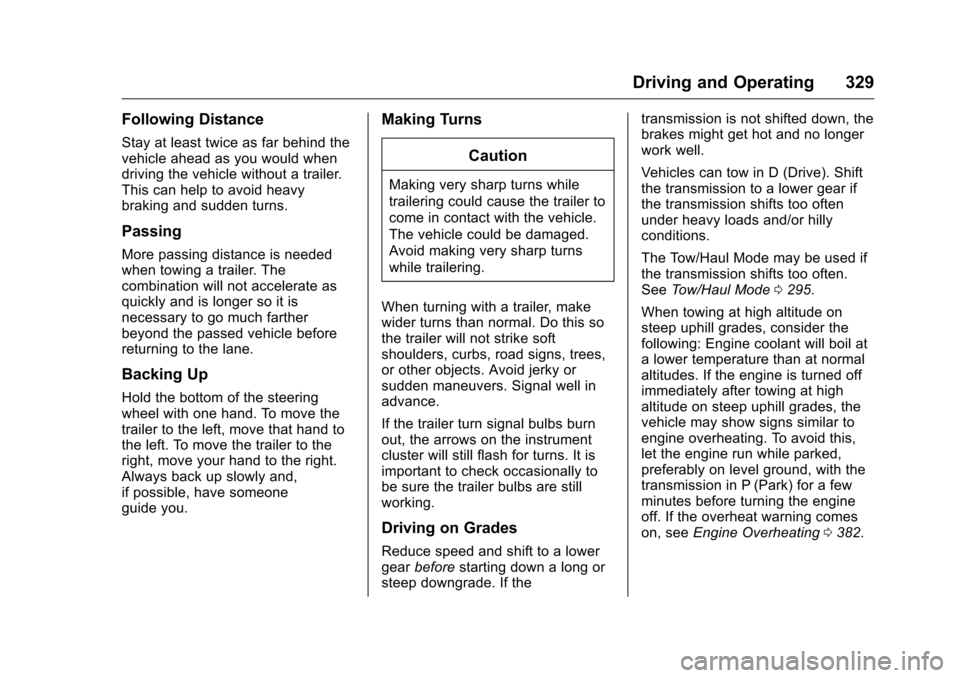
Chevrolet Silverado Owner Manual (GMNA-Localizing-U.S./Canada/Mexico-
9159338) - 2016 - crc - 10/27/15
Driving and Operating 329
Following Distance
Stay at least twice as far behind the
vehicle ahead as you would when
driving the vehicle without a trailer.
This can help to avoid heavy
braking and sudden turns.
Passing
More passing distance is needed
when towing a trailer. The
combination will not accelerate as
quickly and is longer so it is
necessary to go much farther
beyond the passed vehicle before
returning to the lane.
Backing Up
Hold the bottom of the steering
wheel with one hand. To move the
trailer to the left, move that hand to
the left. To move the trailer to the
right, move your hand to the right.
Always back up slowly and,
if possible, have someone
guide you.
Making TurnsCaution
Making very sharp turns while
trailering could cause the trailer to
come in contact with the vehicle.
The vehicle could be damaged.
Avoid making very sharp turns
while trailering.
When turning with a trailer, make
wider turns than normal. Do this so
the trailer will not strike soft
shoulders, curbs, road signs, trees,
or other objects. Avoid jerky or
sudden maneuvers. Signal well in
advance.
If the trailer turn signal bulbs burn
out, the arrows on the instrument
cluster will still flash for turns. It is
important to check occasionally to
be sure the trailer bulbs are still
working.
Driving on Grades
Reduce speed and shift to a lower
gear before starting down a long or
steep downgrade. If the transmission is not shifted down, the
brakes might get hot and no longer
work well.
Vehicles can tow in D (Drive). Shift
the transmission to a lower gear if
the transmission shifts too often
under heavy loads and/or hilly
conditions.
The Tow/Haul Mode may be used if
the transmission shifts too often.
See
Tow/Haul Mode 0295.
When towing at high altitude on
steep uphill grades, consider the
following: Engine coolant will boil at
a lower temperature than at normal
altitudes. If the engine is turned off
immediately after towing at high
altitude on steep uphill grades, the
vehicle may show signs similar to
engine overheating. To avoid this,
let the engine run while parked,
preferably on level ground, with the
transmission in P (Park) for a few
minutes before turning the engine
off. If the overheat warning comes
on, see Engine Overheating 0382.
Page 379 of 533

Chevrolet Silverado Owner Manual (GMNA-Localizing-U.S./Canada/Mexico-
9159338) - 2016 - crc - 10/21/15
378 Vehicle Care
5. Remove the engine air cleaner/filter from the housing. Take
care to dislodge as little dirt as
possible.
6. Clean the engine air cleaner/ filter sealing surfaces and the
housing.
7. Inspect or replace the engine air cleaner/filter.
8. Reverse Steps 2–4 to reinstall the filter cover housing.
{Warning
Operating the engine with the air
cleaner/filter off can cause you or
others to be burned. The air
cleaner not only cleans the air; it
helps to stop flames if the engine
backfires. Use caution when
working on the engine and do not
drive with the air cleaner/filter off.
Caution
If the air cleaner/filter is off, dirt
can easily get into the engine,
which could damage it. Always
have the air cleaner/filter in place
when you are driving.
Cooling System
If the vehicle has the Duramax
diesel engine, see the Duramax
diesel supplement.
The cooling system allows the
engine to maintain the correct
working temperature.
5.3L V8 Engine Shown, 4.3L
V6 Engine and 6.2L V8 Engine Similar
1. Coolant Surge Tank
2. Coolant Surge TankPressure Cap
3. Engine Electric Cooling Fans (Out of View)
{Warning
An electric engine cooling fan can
start even when the engine is not
running. To avoid injury, always
(Continued)
Page 381 of 533
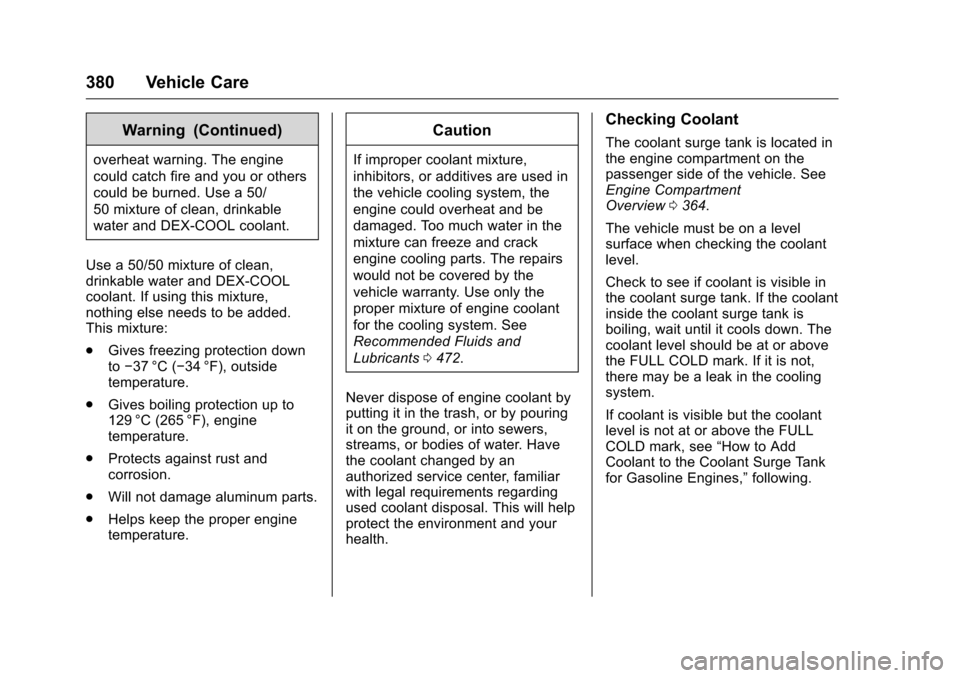
Chevrolet Silverado Owner Manual (GMNA-Localizing-U.S./Canada/Mexico-
9159338) - 2016 - crc - 10/21/15
380 Vehicle Care
Warning (Continued)
overheat warning. The engine
could catch fire and you or others
could be burned. Use a 50/
50 mixture of clean, drinkable
water and DEX-COOL coolant.
Use a 50/50 mixture of clean,
drinkable water and DEX-COOL
coolant. If using this mixture,
nothing else needs to be added.
This mixture:
. Gives freezing protection down
to−37 °C (−34 °F), outside
temperature.
. Gives boiling protection up to
129 °C (265 °F), engine
temperature.
. Protects against rust and
corrosion.
. Will not damage aluminum parts.
. Helps keep the proper engine
temperature.
Caution
If improper coolant mixture,
inhibitors, or additives are used in
the vehicle cooling system, the
engine could overheat and be
damaged. Too much water in the
mixture can freeze and crack
engine cooling parts. The repairs
would not be covered by the
vehicle warranty. Use only the
proper mixture of engine coolant
for the cooling system. See
Recommended Fluids and
Lubricants 0472.
Never dispose of engine coolant by
putting it in the trash, or by pouring
it on the ground, or into sewers,
streams, or bodies of water. Have
the coolant changed by an
authorized service center, familiar
with legal requirements regarding
used coolant disposal. This will help
protect the environment and your
health.
Checking Coolant
The coolant surge tank is located in
the engine compartment on the
passenger side of the vehicle. See
Engine Compartment
Overview 0364.
The vehicle must be on a level
surface when checking the coolant
level.
Check to see if coolant is visible in
the coolant surge tank. If the coolant
inside the coolant surge tank is
boiling, wait until it cools down. The
coolant level should be at or above
the FULL COLD mark. If it is not,
there may be a leak in the cooling
system.
If coolant is visible but the coolant
level is not at or above the FULL
COLD mark, see “How to Add
Coolant to the Coolant Surge Tank
for Gasoline Engines,” following.
Page 383 of 533
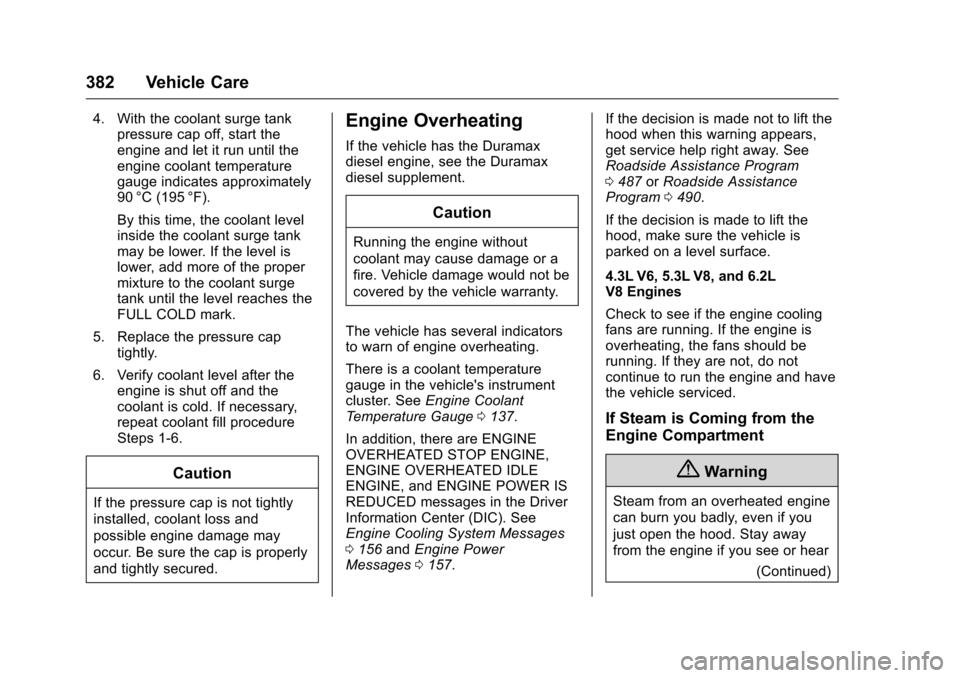
Chevrolet Silverado Owner Manual (GMNA-Localizing-U.S./Canada/Mexico-
9159338) - 2016 - crc - 10/21/15
382 Vehicle Care
4. With the coolant surge tankpressure cap off, start the
engine and let it run until the
engine coolant temperature
gauge indicates approximately
90 °C (195 °F).
By this time, the coolant level
inside the coolant surge tank
may be lower. If the level is
lower, add more of the proper
mixture to the coolant surge
tank until the level reaches the
FULL COLD mark.
5. Replace the pressure cap tightly.
6. Verify coolant level after the engine is shut off and the
coolant is cold. If necessary,
repeat coolant fill procedure
Steps 1-6.
Caution
If the pressure cap is not tightly
installed, coolant loss and
possible engine damage may
occur. Be sure the cap is properly
and tightly secured.
Engine Overheating
If the vehicle has the Duramax
diesel engine, see the Duramax
diesel supplement.
Caution
Running the engine without
coolant may cause damage or a
fire. Vehicle damage would not be
covered by the vehicle warranty.
The vehicle has several indicators
to warn of engine overheating.
There is a coolant temperature
gauge in the vehicle's instrument
cluster. See Engine Coolant
Temperature Gauge 0137.
In addition, there are ENGINE
OVERHEATED STOP ENGINE,
ENGINE OVERHEATED IDLE
ENGINE, and ENGINE POWER IS
REDUCED messages in the Driver
Information Center (DIC). See
Engine Cooling System Messages
0 156 andEngine Power
Messages 0157. If the decision is made not to lift the
hood when this warning appears,
get service help right away. See
Roadside Assistance Program
0
487 orRoadside Assistance
Program 0490.
If the decision is made to lift the
hood, make sure the vehicle is
parked on a level surface.
4.3L V6, 5.3L V8, and 6.2L
V8 Engines
Check to see if the engine cooling
fans are running. If the engine is
overheating, the fans should be
running. If they are not, do not
continue to run the engine and have
the vehicle serviced.
If Steam is Coming from the
Engine Compartment
{Warning
Steam from an overheated engine
can burn you badly, even if you
just open the hood. Stay away
from the engine if you see or hear (Continued)
Page 384 of 533
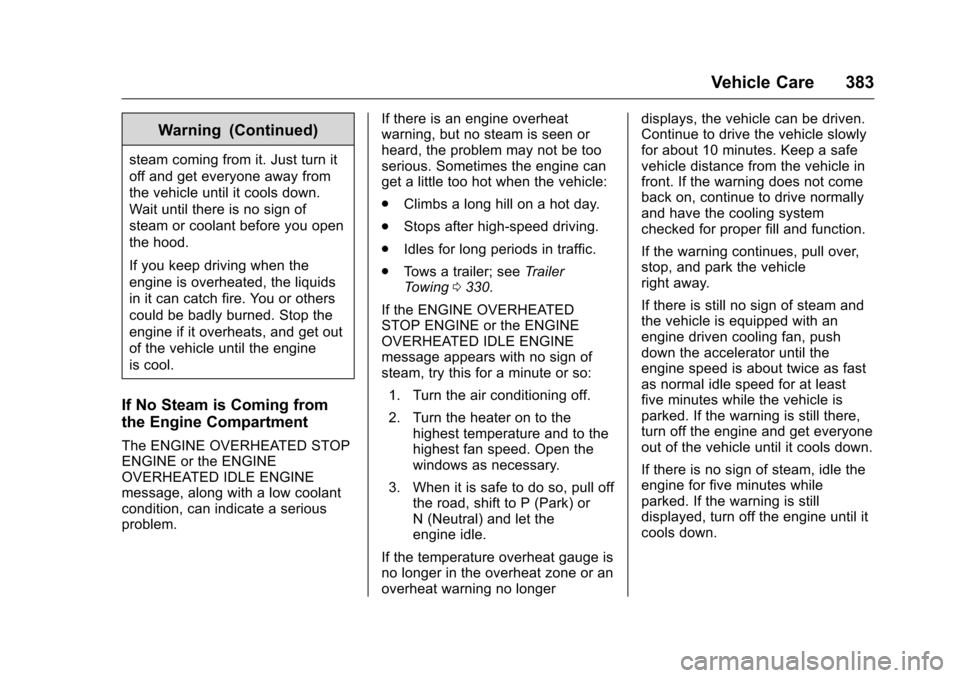
Chevrolet Silverado Owner Manual (GMNA-Localizing-U.S./Canada/Mexico-
9159338) - 2016 - crc - 10/21/15
Vehicle Care 383
Warning (Continued)
steam coming from it. Just turn it
off and get everyone away from
the vehicle until it cools down.
Wait until there is no sign of
steam or coolant before you open
the hood.
If you keep driving when the
engine is overheated, the liquids
in it can catch fire. You or others
could be badly burned. Stop the
engine if it overheats, and get out
of the vehicle until the engine
is cool.
If No Steam is Coming from
the Engine Compartment
The ENGINE OVERHEATED STOP
ENGINE or the ENGINE
OVERHEATED IDLE ENGINE
message, along with a low coolant
condition, can indicate a serious
problem.If there is an engine overheat
warning, but no steam is seen or
heard, the problem may not be too
serious. Sometimes the engine can
get a little too hot when the vehicle:
.
Climbs a long hill on a hot day.
. Stops after high-speed driving.
. Idles for long periods in traffic.
. Tows a trailer; see Trailer
Towing 0330.
If the ENGINE OVERHEATED
STOP ENGINE or the ENGINE
OVERHEATED IDLE ENGINE
message appears with no sign of
steam, try this for a minute or so: 1. Turn the air conditioning off.
2. Turn the heater on to the highest temperature and to the
highest fan speed. Open the
windows as necessary.
3. When it is safe to do so, pull off the road, shift to P (Park) or
N (Neutral) and let the
engine idle.
If the temperature overheat gauge is
no longer in the overheat zone or an
overheat warning no longer displays, the vehicle can be driven.
Continue to drive the vehicle slowly
for about 10 minutes. Keep a safe
vehicle distance from the vehicle in
front. If the warning does not come
back on, continue to drive normally
and have the cooling system
checked for proper fill and function.
If the warning continues, pull over,
stop, and park the vehicle
right away.
If there is still no sign of steam and
the vehicle is equipped with an
engine driven cooling fan, push
down the accelerator until the
engine speed is about twice as fast
as normal idle speed for at least
five minutes while the vehicle is
parked. If the warning is still there,
turn off the engine and get everyone
out of the vehicle until it cools down.
If there is no sign of steam, idle the
engine for five minutes while
parked. If the warning is still
displayed, turn off the engine until it
cools down.
Page 385 of 533
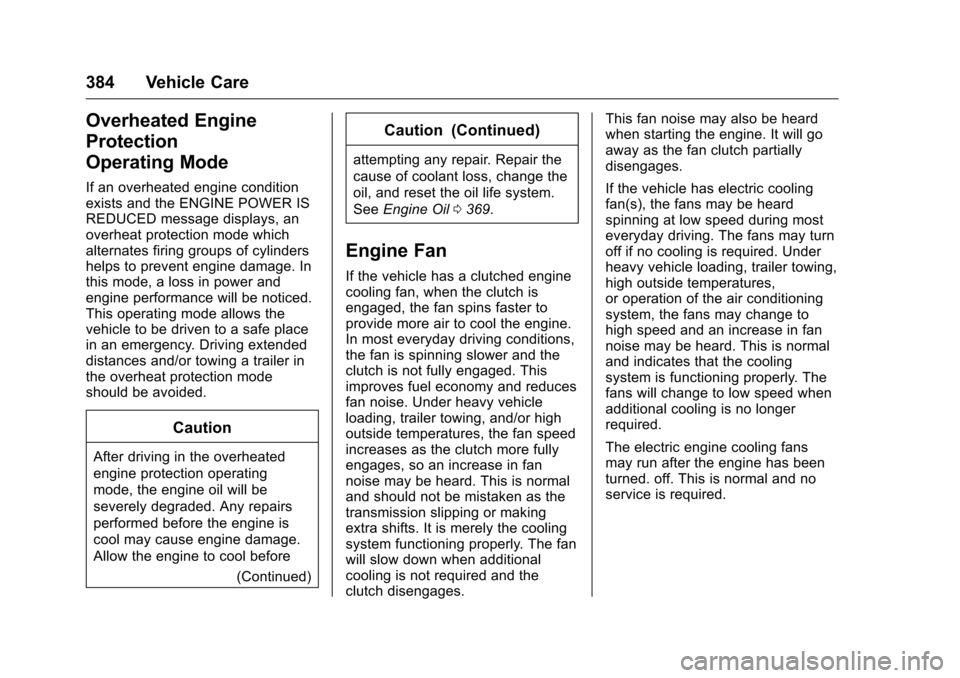
Chevrolet Silverado Owner Manual (GMNA-Localizing-U.S./Canada/Mexico-
9159338) - 2016 - crc - 10/21/15
384 Vehicle Care
Overheated Engine
Protection
Operating Mode
If an overheated engine condition
exists and the ENGINE POWER IS
REDUCED message displays, an
overheat protection mode which
alternates firing groups of cylinders
helps to prevent engine damage. In
this mode, a loss in power and
engine performance will be noticed.
This operating mode allows the
vehicle to be driven to a safe place
in an emergency. Driving extended
distances and/or towing a trailer in
the overheat protection mode
should be avoided.
Caution
After driving in the overheated
engine protection operating
mode, the engine oil will be
severely degraded. Any repairs
performed before the engine is
cool may cause engine damage.
Allow the engine to cool before(Continued)
Caution (Continued)
attempting any repair. Repair the
cause of coolant loss, change the
oil, and reset the oil life system.
SeeEngine Oil 0369.
Engine Fan
If the vehicle has a clutched engine
cooling fan, when the clutch is
engaged, the fan spins faster to
provide more air to cool the engine.
In most everyday driving conditions,
the fan is spinning slower and the
clutch is not fully engaged. This
improves fuel economy and reduces
fan noise. Under heavy vehicle
loading, trailer towing, and/or high
outside temperatures, the fan speed
increases as the clutch more fully
engages, so an increase in fan
noise may be heard. This is normal
and should not be mistaken as the
transmission slipping or making
extra shifts. It is merely the cooling
system functioning properly. The fan
will slow down when additional
cooling is not required and the
clutch disengages. This fan noise may also be heard
when starting the engine. It will go
away as the fan clutch partially
disengages.
If the vehicle has electric cooling
fan(s), the fans may be heard
spinning at low speed during most
everyday driving. The fans may turn
off if no cooling is required. Under
heavy vehicle loading, trailer towing,
high outside temperatures,
or operation of the air conditioning
system, the fans may change to
high speed and an increase in fan
noise may be heard. This is normal
and indicates that the cooling
system is functioning properly. The
fans will change to low speed when
additional cooling is no longer
required.
The electric engine cooling fans
may run after the engine has been
turned. off. This is normal and no
service is required.
Page 523 of 533
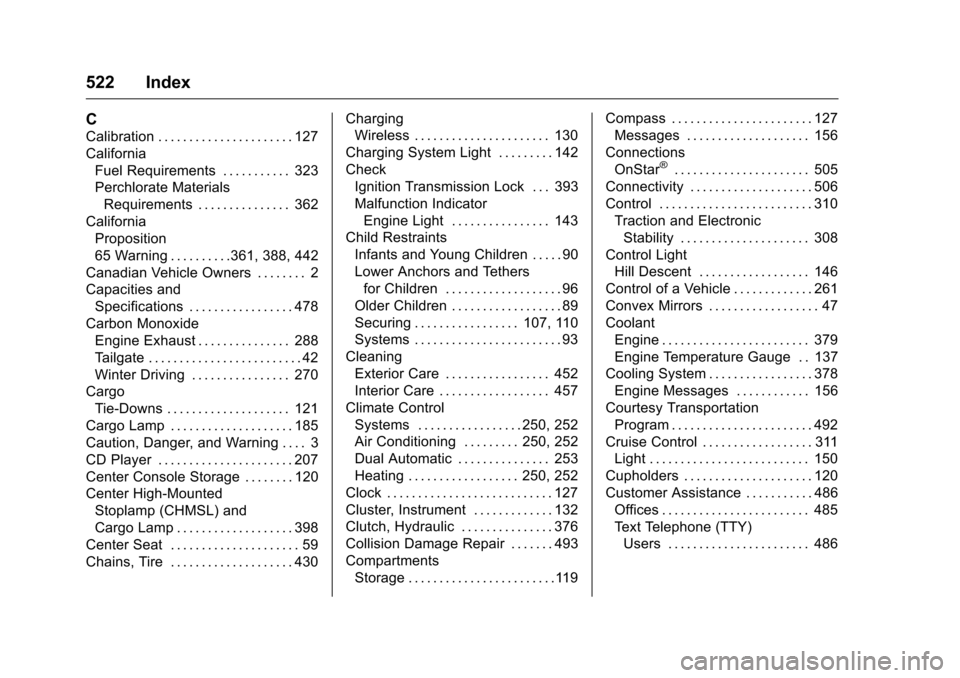
Chevrolet Silverado Owner Manual (GMNA-Localizing-U.S./Canada/Mexico-
9159338) - 2016 - crc - 10/21/15
522 Index
C
Calibration . . . . . . . . . . . . . . . . . . . . . . 127
CaliforniaFuel Requirements . . . . . . . . . . . 323
Perchlorate MaterialsRequirements . . . . . . . . . . . . . . . 362
California Proposition
65 Warning . . . . . . . . . .361, 388, 442
Canadian Vehicle Owners . . . . . . . . 2
Capacities and
Specifications . . . . . . . . . . . . . . . . . 478
Carbon Monoxide Engine Exhaust . . . . . . . . . . . . . . . 288
Tailgate . . . . . . . . . . . . . . . . . . . . . . . . . 42
Winter Driving . . . . . . . . . . . . . . . . 270
Cargo Tie-Downs . . . . . . . . . . . . . . . . . . . . 121
Cargo Lamp . . . . . . . . . . . . . . . . . . . . 185
Caution, Danger, and Warning . . . . 3
CD Player . . . . . . . . . . . . . . . . . . . . . . 207
Center Console Storage . . . . . . . . 120
Center High-Mounted Stoplamp (CHMSL) and
Cargo Lamp . . . . . . . . . . . . . . . . . . . 398
Center Seat . . . . . . . . . . . . . . . . . . . . . 59
Chains, Tire . . . . . . . . . . . . . . . . . . . . 430 Charging
Wireless . . . . . . . . . . . . . . . . . . . . . . 130
Charging System Light . . . . . . . . . 142
Check Ignition Transmission Lock . . . 393
Malfunction IndicatorEngine Light . . . . . . . . . . . . . . . . 143
Child Restraints Infants and Young Children . . . . . 90
Lower Anchors and Tethersfor Children . . . . . . . . . . . . . . . . . . . 96
Older Children . . . . . . . . . . . . . . . . . . 89
Securing . . . . . . . . . . . . . . . . . 107, 110
Systems . . . . . . . . . . . . . . . . . . . . . . . . 93
Cleaning Exterior Care . . . . . . . . . . . . . . . . . 452
Interior Care . . . . . . . . . . . . . . . . . . 457
Climate Control Systems . . . . . . . . . . . . . . . . . 250, 252
Air Conditioning . . . . . . . . . 250, 252
Dual Automatic . . . . . . . . . . . . . . . 253
Heating . . . . . . . . . . . . . . . . . . 250, 252
Clock . . . . . . . . . . . . . . . . . . . . . . . . . . . 127
Cluster, Instrument . . . . . . . . . . . . . 132
Clutch, Hydraulic . . . . . . . . . . . . . . . 376
Collision Damage Repair . . . . . . . 493
Compartments Storage . . . . . . . . . . . . . . . . . . . . . . . .119 Compass . . . . . . . . . . . . . . . . . . . . . . . 127
Messages . . . . . . . . . . . . . . . . . . . . 156
Connections OnStar
®. . . . . . . . . . . . . . . . . . . . . . 505
Connectivity . . . . . . . . . . . . . . . . . . . . 506
Control . . . . . . . . . . . . . . . . . . . . . . . . . 310 Traction and Electronic
Stability . . . . . . . . . . . . . . . . . . . . . 308
Control Light Hill Descent . . . . . . . . . . . . . . . . . . 146
Control of a Vehicle . . . . . . . . . . . . . 261
Convex Mirrors . . . . . . . . . . . . . . . . . . 47
Coolant
Engine . . . . . . . . . . . . . . . . . . . . . . . . 379
Engine Temperature Gauge . . 137
Cooling System . . . . . . . . . . . . . . . . . 378
Engine Messages . . . . . . . . . . . . 156
Courtesy Transportation Program . . . . . . . . . . . . . . . . . . . . . . . 492
Cruise Control . . . . . . . . . . . . . . . . . . 311 Light . . . . . . . . . . . . . . . . . . . . . . . . . . 150
Cupholders . . . . . . . . . . . . . . . . . . . . . 120
Customer Assistance . . . . . . . . . . . 486 Offices . . . . . . . . . . . . . . . . . . . . . . . . 485
Text Telephone (TTY)Users . . . . . . . . . . . . . . . . . . . . . . . 486
Page 524 of 533
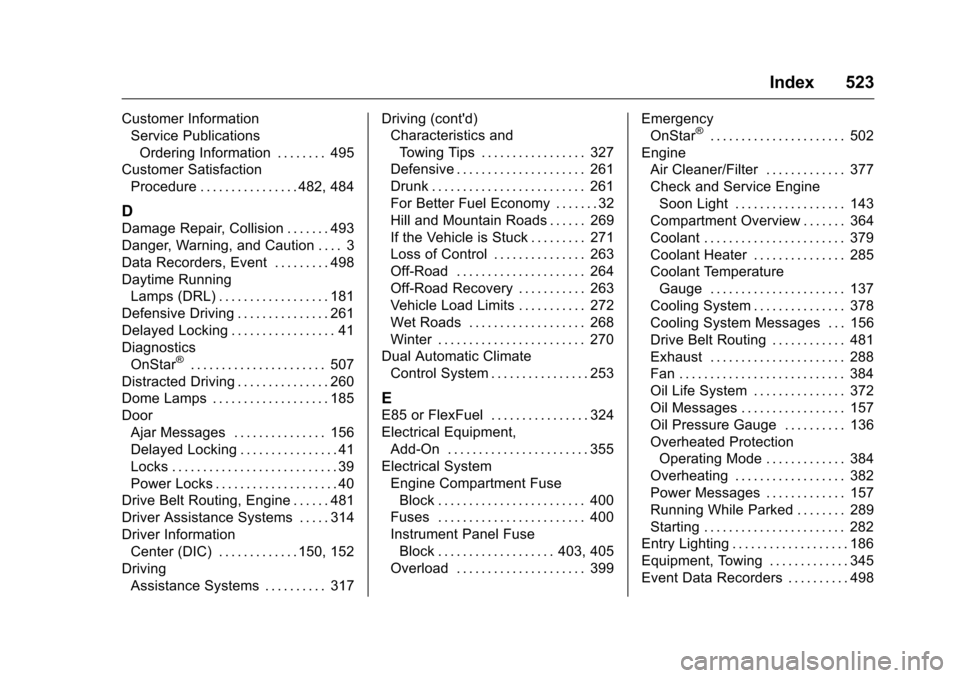
Chevrolet Silverado Owner Manual (GMNA-Localizing-U.S./Canada/Mexico-
9159338) - 2016 - crc - 10/21/15
Index 523
Customer InformationService Publications
Ordering Information . . . . . . . . 495
Customer Satisfaction Procedure . . . . . . . . . . . . . . . . 482, 484
D
Damage Repair, Collision . . . . . . . 493
Danger, Warning, and Caution . . . . 3
Data Recorders, Event . . . . . . . . . 498
Daytime RunningLamps (DRL) . . . . . . . . . . . . . . . . . . 181
Defensive Driving . . . . . . . . . . . . . . . 261
Delayed Locking . . . . . . . . . . . . . . . . . 41
Diagnostics OnStar
®. . . . . . . . . . . . . . . . . . . . . . 507
Distracted Driving . . . . . . . . . . . . . . . 260
Dome Lamps . . . . . . . . . . . . . . . . . . . 185
Door
Ajar Messages . . . . . . . . . . . . . . . 156
Delayed Locking . . . . . . . . . . . . . . . . 41
Locks . . . . . . . . . . . . . . . . . . . . . . . . . . . 39
Power Locks . . . . . . . . . . . . . . . . . . . . 40
Drive Belt Routing, Engine . . . . . . 481
Driver Assistance Systems . . . . . 314
Driver Information Center (DIC) . . . . . . . . . . . . . 150, 152
Driving Assistance Systems . . . . . . . . . . 317 Driving (cont'd)
Characteristics and
Towing Tips . . . . . . . . . . . . . . . . . 327
Defensive . . . . . . . . . . . . . . . . . . . . . 261
Drunk . . . . . . . . . . . . . . . . . . . . . . . . . 261
For Better Fuel Economy . . . . . . . 32
Hill and Mountain Roads . . . . . . 269
If the Vehicle is Stuck . . . . . . . . . 271
Loss of Control . . . . . . . . . . . . . . . 263
Off-Road . . . . . . . . . . . . . . . . . . . . . 264
Off-Road Recovery . . . . . . . . . . . 263
Vehicle Load Limits . . . . . . . . . . . 272
Wet Roads . . . . . . . . . . . . . . . . . . . 268
Winter . . . . . . . . . . . . . . . . . . . . . . . . 270
Dual Automatic Climate Control System . . . . . . . . . . . . . . . . 253
E
E85 or FlexFuel . . . . . . . . . . . . . . . . 324
Electrical Equipment,Add-On . . . . . . . . . . . . . . . . . . . . . . . 355
Electrical System Engine Compartment FuseBlock . . . . . . . . . . . . . . . . . . . . . . . . 400
Fuses . . . . . . . . . . . . . . . . . . . . . . . . 400
Instrument Panel Fuse Block . . . . . . . . . . . . . . . . . . . 403, 405
Overload . . . . . . . . . . . . . . . . . . . . . 399 Emergency
OnStar
®. . . . . . . . . . . . . . . . . . . . . . 502
Engine Air Cleaner/Filter . . . . . . . . . . . . . 377
Check and Service EngineSoon Light . . . . . . . . . . . . . . . . . . 143
Compartment Overview . . . . . . . 364
Coolant . . . . . . . . . . . . . . . . . . . . . . . 379
Coolant Heater . . . . . . . . . . . . . . . 285
Coolant Temperature Gauge . . . . . . . . . . . . . . . . . . . . . . 137
Cooling System . . . . . . . . . . . . . . . 378
Cooling System Messages . . . 156
Drive Belt Routing . . . . . . . . . . . . 481
Exhaust . . . . . . . . . . . . . . . . . . . . . . 288
Fan . . . . . . . . . . . . . . . . . . . . . . . . . . . 384
Oil Life System . . . . . . . . . . . . . . . 372
Oil Messages . . . . . . . . . . . . . . . . . 157
Oil Pressure Gauge . . . . . . . . . . 136
Overheated Protection Operating Mode . . . . . . . . . . . . . 384
Overheating . . . . . . . . . . . . . . . . . . 382
Power Messages . . . . . . . . . . . . . 157
Running While Parked . . . . . . . . 289
Starting . . . . . . . . . . . . . . . . . . . . . . . 282
Entry Lighting . . . . . . . . . . . . . . . . . . . 186
Equipment, Towing . . . . . . . . . . . . . 345
Event Data Recorders . . . . . . . . . . 498